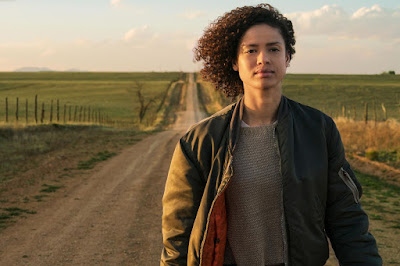Hunted by mysterious forces, a young woman who has supernatural abilities must go on the run when her powers are discovered. With nowhere else to go, she flees back to her family and the farmhouse she abandoned long ago.
Remembering when Brightburn was announced, there was a lot of excitement for what would be a variation on the usual superhero genre; moving into the horror side of the spectrum. Ultimately, it left viewers divided as to whether it succeeded in what it set out to do. Fast Color is not dissimilar to that. Fast Color brings the superhero story into a more drama-driven narrative. It's release in the States poorly coincided with that of Avengers: Endgame and it soon disappeared off of the radar, and out of theatres.
Fast Color is set in a dystopian, post-apocalyptic world that has had no rain for eight years, with water now being valued more than accommodation. In what could have been an origin story for the Mad Max film franchise, Fast Color has simple but effect set design, with a very dry, brown colour palette that could easily share a cinematic universe with the likes of Logan or Breaking Bad.
In nearly every respect, Fast Color is the polar opposite of Avengers: Endgame. This is an incredibly small scale and intimate affair, that focuses on a family of ethnic minorities that have powers that they are actively trying to suppress. It looks at the consequences of having a destructive power that one cannot control, that concern of unintentionally hurting people, the fear of being hunted and experimented on, and the consequences of genetic powers that can be passed on. There are a lot of directions that the film could go, but much to its detriment, despite bringing up these deep and powerful emotive ideas, Fast Color has a singular focus.
A singular focus is good for ensuring a strong narrative direction, but it has the downside of making the story entirely too predictable because there are no other remaining options as to what could happen. The small scale, with a singular focus, means there are no surprises at all, and the characters are less developed than they could be, which reduces audience engagement. The small contained story with a singular focus also means there is a fair amount of exposition involved without a lot of world-building. The first act creates a sense of intrigue and curiosity which is never satisfied. Fast Color answers very few of the "why" questions. It is isolated and disregards everything that isn't directly related to the main arc.
M. Night Shyamalan's 2000 film Unbreakable is another film that had a dramatic focus, proving to be a character study, rather than an action film. It worked well because it had interesting characters. Fast Color is not so lucky. The lack of character depth makes them far less appealing, and while the colour of their skin will be enough for certain ethnicities to be able to relish in the representation on screen, it wasn't until the climax of the film when I started to care at all about our main protagonist. All because the protagonist was more of an antagonist than the actual antagonists were.
But Fast Color still manages to put forward a good attempt. It has some brilliant moments that are visually stunning (helped out by some strong strings in the score), and an opening scene that throws you right into the deep end. Our main characters put on a strong performance but were let down by either the script and/or direction from Julia Hart.
It's slow, exposition-heavy, and missing a lot of potential from a lack of lore and world-building, but it builds enough engagement by the conclusion, that you wish you could see what happens next. For a low budget, lo-fi indie film, that's pretty impressive (which is why I'm glad to see Amazon will be making a full series out of the concept).




